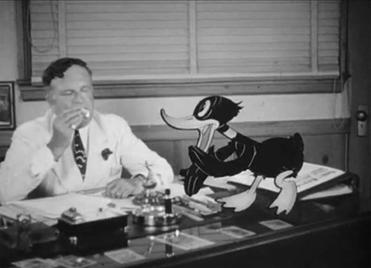Forty plus years before Who Framed Roger Rabbit, You Ought To Be In Pictures depicted cartoons as employees of a very real business, merging animation with live-action in the process. The (second) longest of the Golden Age shorts, Pictures is as playful and zippy as can be expected from the likes of the great Fritz Freleng, in his first short for Warners in two years. Quite a homecoming too as a tribute to (and ribbing of) Schleslinger Productions. The short incorporates Leon Schlesinger as himself – one of the few live action actors not dubbed by Mel Blanc here so that’s his real voice on the screen – writer Michael Maltese, Chuck Jones, and Bob Clampett mostly as themselves.
The film opens at the Schlesinger headquarters as an animator works dilligently, nobly on a large cell drawing of Porky Pig. Any sense of this as behind the scenes hagiography quickly evaporates though when “LUNCH” is heard and a very cartoon stampede of animators rushes out the door. The rest of the short follows Porky, stenciled onto his paper but capable of walking about our world, as he gets suckered by Daffy Duck into making a bid for Hollywood over animation. (Daffy tells him that he can make “nine grand a week”, in a ploy to get Porky out of the way.) Porky then officially enters live-action to bashfully ask Mr. Schlesinger out of his contract. Schlesinger isn’t too upset, revealing in a classic Merrie Melodies aside to the audience that he knows Porky will come back.
The rest of the short follows Porky adventuring through the Warner Bros studio lot, getting chased by the security guard repeatedly (a very silent filmesque Maltese) and accidentally interrupting a dance number. The influence on Rabbit is apparent in how cartoon “actors” are working stiffs and without the power of an Oliver Hardy, the star Porky tries to pass himself off as. Hollywood is as cynical and absurd as anything else in the Looney Tunes universe.
Meanwhile Daffy pitches Schlesinger on a big musical number of his own, the animation and “real” intersecting as his feet kick actual paper off a desk. (Critics have pointed to this fame-hungry Daffy as bridging the gap between Clampett’s and Jones’ respective depictions.) But after Porky breathlessly speeds back to Schlesinger Productions (his tiny animated car veering between 1939 automobiles) and begs for his job back, Leon happily gives in and all balance is restored when Porky beats the crap out of Daffy for his scheming.
Throughout Pictures I thought of the classic Gertie The Dinosaur film, how McCay brought Gertie to life not just by drawing her, but by acting as if she was sentient, reacting to her. Computer generated elements mixing with live-action doesn’t draw the same response from the audience; the animation is designed to look and feel like flesh, to seem something like our own bodies. Porky and Daffy are flat, drawn, and there’s something very magical in this specific process, in the raw belief and ritual required that makes combining the mediums genuinely powerful. Goofy as You Ought To Be In Pictures is, it captures that magic.


